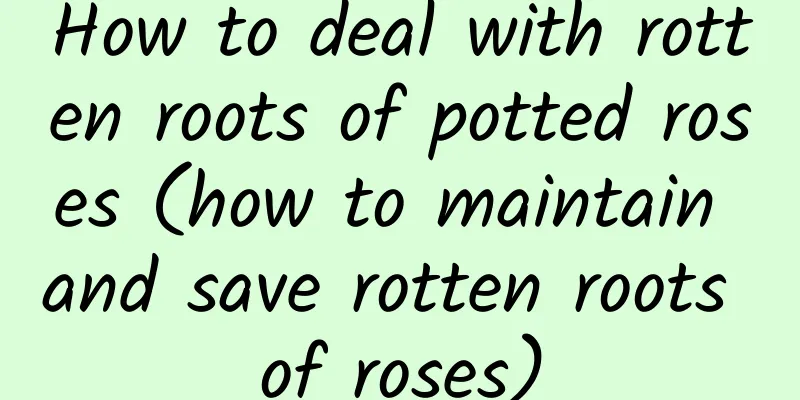How to deal with rotten roots of potted roses (how to maintain and save rotten roots of roses)

Causes of rose root rotThere are generally two situations that cause rose root rot: one is excessive watering; the other is excessive fertilization. If you water too much and the soil in the pot remains moist for a long time, the breathing of the root system will be affected and root rot will occur. In addition, if you fertilize too much or use some raw fertilizers when fertilizing, root rot will also occur. Specifically, the following situations are mentioned below. 1. Root rot occurs due to high water contentOne of the main reasons for rose root rot is too much water. Although roses are plants that prefer high humidity and sufficient water, for most novice flower lovers, once they plant a rose, they are always worried about the lack of water. Even the hardiest roses cannot withstand long-term saturated watering. In addition, most flower lovers use potted roses, and the soil for potted roses is mostly self-mixed media. Some of them have strong water absorption and poor hydrophobicity, which is also one of the reasons for root waterlogging and root rot. Potted roses are different from ground-planted roses. They do not have such strong self-water control capabilities, so potted roses are more likely to accumulate water at the roots and cause root rot. 2. TransplantationIn addition, roses often suffer from root rot after transplanting, which is mainly manifested in the common yellow leaves and occasional wilting symptoms that appear just after the roses are planted. During the transplanting process of roses, the fibrous roots will be damaged to a certain extent. Even if you are very careful, you cannot guarantee that every rose will pass through your hands, and you cannot guarantee that no fibrous roots will be damaged. Therefore, yellow leaves often appear after planting. Sometimes they will recover slowly, but sometimes if they are not properly cared for, the roots may continue to rot. Especially when the rose has just been transplanted into the flowerpot, the root system is still in the recovery stage and has not yet fit tightly with the newly added soil. Its limited ability to absorb water can easily lead to the water at the root being unable to be absorbed and accumulating at the roots. 3. Fertilizer damageFertilizer damage can also cause root rot in roses. On the one hand, if we force growth for a long time and give roses excessive and frequent fertilizers, although the amount is not particularly large, it will not cause acute fertilizer damage. However, long-term root pressure will overwhelm the rose's root system. Once water accumulates at the roots or there are other problems, root rot is inevitable. How to deal with rose root rot and save itWhen the rose roots rot, the root system's absorption and transmission of nutrients will be affected, which in turn affects the growth of the above-ground parts. Some adverse growth conditions may occur in the season, such as yellowing leaves and falling leaves when touched by water. After these conditions occur, it is easy to find the cause by combining the recent watering and fertilization conditions. If the problem is caused by overwatering, temporarily control the water. If the problem is caused by overfertilization, water more to dilute the fertilizer effect. After a certain period of time, if the rose resumes normal growth, it does not need to be treated and normal maintenance is sufficient. In the above situation, the root system of the rose is only slightly damaged and has not rotted or has only partially rotted. It can recover by controlling water and fertilizer. If a serious situation occurs, such as the leaves of the entire plant drooping and falling, and a large number of leaves falling, it proves that the situation is more serious and you should consider checking the root system. Check the root system and if there is any rot, if only a small part of the roots are rotten, cut off the rotten roots in time and then soak and disinfect them. Replace the soil with new one and repot it. After potting, water it thoroughly and place it in a cool and ventilated place to help the seedlings grow. If the root system is severely rotten, it is unlikely to survive and you can only cut healthy branches for cuttings. |
<<: What should I do if the new branches of roses grow thin and long?
Recommend
Breeding methods and precautions for Fenglan
1. Temperature Orchids love shade and hate direct...
Is Anhui suitable for growing litchi trees? Which variety is better for growing litchi?
Planting lychee trees in Anhui Litchi cannot be g...
Begonia Flower Language
1. Flower language introduction The crabapple flo...
Top 10 Most Shade-Tolerant Indoor Plants
1. Silver Queen The leaves of Silver Queen are ri...
How to propagate zinnias by cuttings
1. Cutting selection When choosing cuttings, peop...
The efficacy and contraindications of lettuce
1. Efficacy and Function 1. Improve digestion Let...
What kind of soil is suitable for planting jujube trees?
Date tree soil requirements Jujube trees prefer s...
The propagation method of mosaic cassava
1. Growth environment It likes a warm growing env...
How to grow leopard arrowroot?
Suitable growth habit Leopard arrowroot is a kind...
Precautions for rose repotting in summer Specific steps for changing the soil and repotting roses (complete)
Things to note when changing rose pots in summer ...
The efficacy and function of hyacinth
For people to enjoy Ornamental purpose is an impo...
Keeping these climbing plants at home can save a lot of decoration money!
Hoya When the ball orchid blooms, it looks like a...
Can river water be used to water succulents?
Can river water be used to water succulents? Rive...
What to do if the mimosa withers
Reducing the sources of mimosa wilting When growi...
Common types of flower diseases
Common types of flower diseases Plant disease typ...









